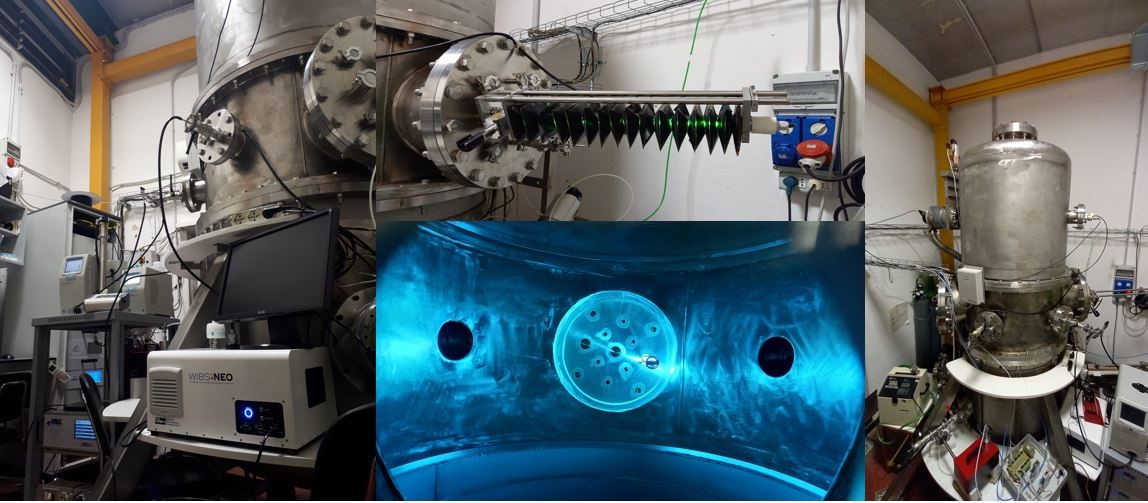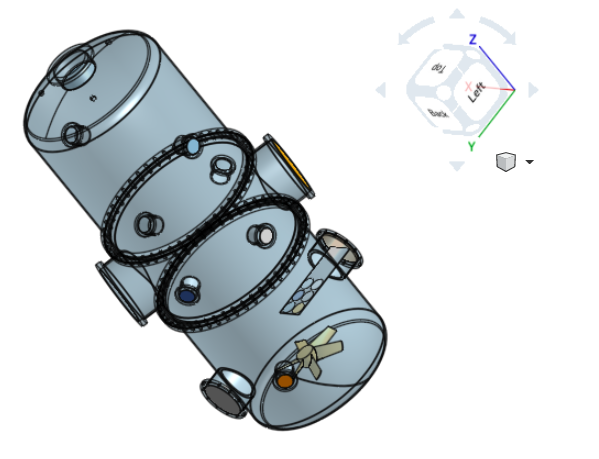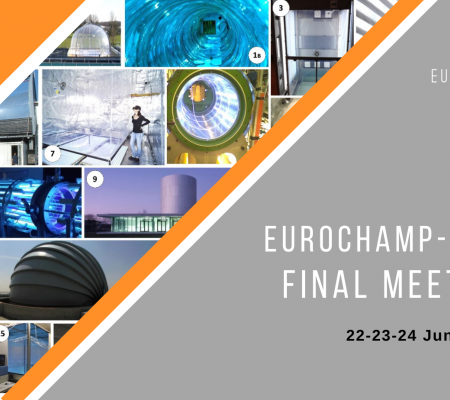| General information |
| Access mode |
Physical access: “hands-on” access to ENV chamber
Remote access: instrument calibration |
| Infrastructure name and acronym |
Chamber for Aerosol Modelling and Bio-aerosol Research (ChAMBRe) |
| Photos |
 |
| Location |
Genoa, Italy
44°24'10.6"N 8°58'19.0"E (44.402940, 8.971941) |
| Website |
https://labfisa.ge.infn.it/ |
| Legal name of organisation operating the infrastructure |
Istituto Nazionale di Fisica Nucleare (INFN) – Sezione di Genova |
| Description of the infrastructure |
| Brief general description of the infrastructure to which access is offered |
ChAMBRe is a stainless steel chamber with a volume of about 2.2 m3 equipped to perform studies on bio-aerosol and/or on the optical behavior of aerosol species. Other activities (e.g.: calibration of low-cost sensors, validation of new aerosol samplers, production of aerosol samples for toxicological studies, etc.) are carried out too.
The chamber can be operated in overpressure regime (up to +50 mbar with respect to ambient pressure) and down to 10-5 mbar. Venting and refilling can be both via cylinders and filtered ambient air. A solar simulator is going to be installed providing up to 3 SUN equivalent power (AM1.5G filter) through a circular viewport (diameter: 25 cm). Aerosol lifetime ranges from 2 to 20 hours depending on particles size. A set of flanges and apertures allows both sampling and exposures (e.g.: petri dishes to collect viable bio-aerosol, relatively large objects, etc.). UV lamps to produce ozone and/or to sterilize the chamber interior can be inserted without perturbing the internal conditions. The set of instruments permanently connected to the chamber includes:
- Relative humidity, temperature and pressure gauges.
- Gas monitors (CO/CO2, NOx, SO2, O3, BTEX).
- Scanning Mobility Particle Sizer (SMPS, TSI 3938) and Optical Particle Sizer (OPS, TSI 3330).
- Wide Band Integrated Bio-aerosol Sensor (WIBS NEO, Droplet M&T).
- Photo-acoustic monitors (PAXS, Droplet M&T, λ =870, 532, 405 nm).
- Aerosol nebulizers: Collison, BLAM and SLAG (CH-Technologies).
- TSI Flow Focusing Monodisperse Aerosol Generator.
- Soot generator: Miniature Inverted Soot Generator (MISG, Argonaut Scientific Corporation).
- Dust re-suspender.
- Sampling ports for sampling on filters and multi-stage impactors.
- Inlets for gaseous species from cylinders (CO2, CO, NO, NO2, SO2, CH4) with mass flow controllers.
- Viable bio-aerosol samplers (flow impingers, single-Stage Viable Andersen Cascade Impactor)
- Automatized petri-slides exposer
- Fiber-optic Spectrometer, calibrated in the range 200-1100nm
The ChAMBRe facility is part of a laboratory (www.labfisa.ge.infn.it) equipped with a comprehensive set of instruments for atmospheric aerosol characterization:
- Energy dispersive X-ray fluorescence spectrometer (ED-XRF) and PIXE (at the INFN- LABEC facility).
- Ion Chromatography for anions, cations and sugars.
- Multi-wavelength Absorbance Analyzer (MWAA) for non-destructive BC and BrC determination.
- Two-wavelength Thermo-optical analyzer of TC/OC/EC.
- PM10, PM2.5 and PM1 Low volume sequential CEN samplers.
- Multi-stage inertial impactor (13-stage rotating nanoMoudi).
- Two-stage streaker and STRAS PM samplers.
- Micro-balance (1 g) and weighting room with temperature and R.H. control.
- Laminar flow hoods.
- Basic biological lab equipment for culture analysis in vitro (isolation, identification, growth) and biochemical tests (e.g. catalase and oxidase): autoclave, vortex, centrifuge and micro-centrifuge, water purification system Milli-Q, incubator for temperature control, Steril-VBH Compact “microbiological safety” cabinet, steri-cycle HEPA Class 100 incubator;
- Light and phase-contrast microscopes for microorganisms size, shape, colony morphology characterization;
- Optical microscope for bacterial detection and live/dead discrimination by epifluorescence with specific dyes and for immunoassay fluorescence to label antigenic bacterial target, fluorescent molecule or enzyme.
|
| Services currently offered by the infrastructure and its research environment |
- Study of the correlation between bacteria viability and atmospheric pollutants
- Test of aerosol samplers, gas monitors, atmospheric sensors
- Test of bio-aerosols monitors
- Test of aerosol samplers
- Preparation of artificial aerosol samples deposited on different media
- Full compositional analysis of aerosol samples
|
| Modalities of access and support offered under EUROCHAMP-2020 |
| Typical duration of work |
A typical experiment comprises a number of maintenance and setup activities such as cleaning, filling and emptying the chamber; prepare and cultivate bacteria strains to inject, sterilize all the equipment. Normally, when operating with bacteria, one experiment per day can be performed. For experimental efficiency, access to the chamber is best provided in "campaign mode" over 5 days or more.
|
| Community/user type served |
• Academic sector (expert and early stage researchers)
• Industrial users / SMEs for sensors and other equipment testing |
| Scientific and technical support offered |
- Technicians and Technologists
- Mechanical and electronic workshop (included 3D printing of plastic and metallic objects), computers farm for scientific calculation
- Research scientists
- Access to expertise of senior scientists:
- Prof. Paolo Prati: atmospheric aerosol characterization, instruments set-up and validation, source apportionment.
- Prof. Camilla Costa: chemistry of atmospheric aerosol, FESEM microscopy, nanoparticles
- Dr. Dario Massabò: optical properties of atmospheric aerosols, multi-wavelength absorbance analyses
- Dr. Elena Gatta: bacteria and cellular biology, microbiology.
|
| Logistic and administrative support offered |
- Instrument shipping
- Booking of accommodation
|
| Person in charge of the infrastructure |
Prof. Paolo Prati, group leader, prati@ge.infn.it
|
| Extended technical information |
| Physical |
ChAMBRe is a cylindrical stainless steel simulation chamber.
Dimensions:
Diameter: 0.997 m
Height: 2.940 m
Volume: 2140 litres
S/V ratio: 4.4 m-1
Projected surface area: 0.785 m2
Temperature range: 18 - 25 °C
Pressure range: 10-5 - 1030 mbar
Relative Humidity range: 0 to 99 % |
| Mechanical description |
 |
| Irradiation spectra |
The deployment of the solar simulator (AM1.5G filter with power tuning through power modulation and passive attenuators) is ongoing and will be completed within August 2021. A sketch of the set-up is given below:

|
| Size dependent aerosol loss/lifetime |
 |
| Auxiliary mechanism |
Reactions constants Note
O3 → O3_Wall 3.04± 0.40 x 10-5 s-1 depending on the cleaning procedure
|
| Description paper |
Dario Massabò, Silvia Giulia Danelli, Paolo Brotto, Antonio Comite, Camilla Costa, Andrea Di Cesare, Jean François Doussin, Federico Ferraro, Paola Formenti, Elena Gatta, Laura Negretti, Maddalena Oliva, Franco Parodi, Luigi Vezzulli, and Paolo Prati. ChAMBRe: a new atmospheric simulation Chamber for Aerosol Modelling and Bio-aerosol Research. Atmos. Meas. Tech., 11, 5885–5900, 2018, DOI: 10.5194/amt-11-5885-2018. |









